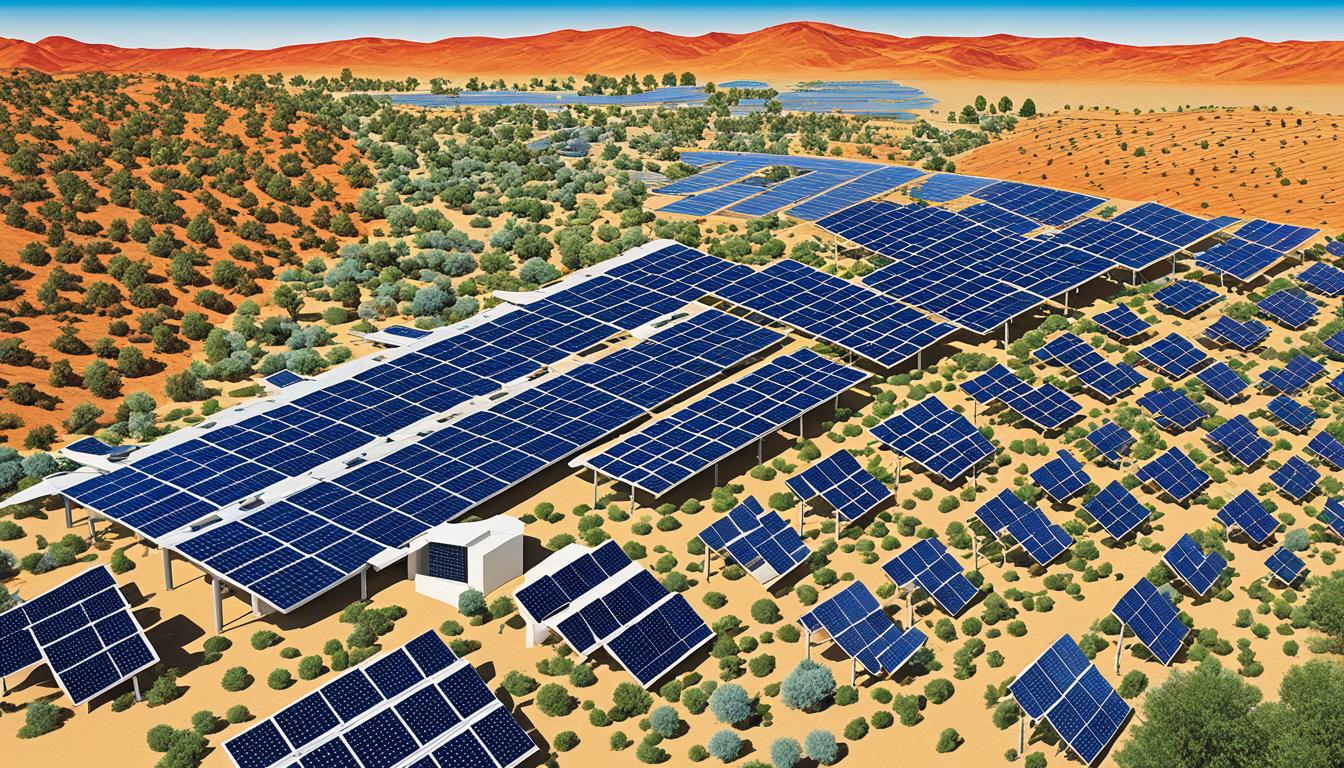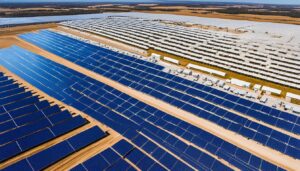
Welcome to Photovoltaics International, your go-to resource for understanding the global solar power industry and navigating the ever-changing landscape of solar energy. In this article, we will explore key developments and advancements in the field, from international energy collaborations to breakthroughs in perovskite solar technology. Join me as we delve into the exciting world of solar energy and its role in shaping a sustainable future.
Key Takeaways:
- Solar energy is a crucial part of the global energy transition towards cleaner and more sustainable alternatives.
- The International Energy Agency’s Ministerial Meeting emphasizes the commitment to renewable energy, energy efficiency, and reducing emissions.
- Advancements in perovskite solar technology offer greener and more efficient alternatives to traditional solar modules.
- The use of lead and tin-free perovskite materials addresses toxicity and stability concerns, paving the way for scalable manufacturing processes.
- Sustainable energy solutions are becoming more attractive with improved power conversion efficiency and long-term stability of solar modules.
Advancements in Perovskite Solar Technology
Researchers at the Center for Hybrid and Organic Solar Energy in Rome have made significant progress in the development of perovskite solar modules that are both lead and tin-free. By utilizing a light absorber material based on antimony, these modules address the challenges associated with traditional perovskite technology, including potential toxicity and instability.
This breakthrough in perovskite solar technology offers a range of benefits, including improved stability and increased power conversion efficiency. By introducing two cations into the precursor mixture, the researchers achieved remarkable advancements in long-term stability and the ability to withstand high temperatures.
The modified Sb-based perovskite cells demonstrate positive stability behavior in air and thermal durability, making them ideal for scalable manufacturing processes. These advancements pave the way for the large-scale production of greener photovoltaics and offer alternatives to toxic and unstable materials.

Stability and Efficiency Achievements
- Lead and tin-free perovskite solar modules
- Improved stability and long-term durability
- Positive stability behavior in air
- Excellent thermal durability at high temperatures
- Scalable manufacturing processes
These advancements in perovskite solar technology have significant implications for the future of photovoltaics. By offering greener alternatives with enhanced stability and power conversion efficiency, they help to accelerate the adoption of sustainable energy solutions.
The Promise of Sustainable Energy Solutions
The development of stable lead and tin-free perovskite solar modules holds promise for sustainable energy solutions. The use of a material based on antimony as a light absorber addresses concerns related to lead toxicity and provides alternatives to unstable tin-based perovskites. The improved power conversion efficiency and long-term stability of these modules under real-world conditions make them an attractive option for sustainable energy technologies. Advancements in materials science contribute to the development of greener photovoltaics and pave the way for transformative energy solutions that are environmentally friendly and efficient.
| Benefits of Stable Lead and Tin-free Perovskite Solar Modules |
|---|
| 1. Reduced environmental concerns due to the absence of toxic lead-based perovskites |
| 2. Long-term stability in real-world conditions, ensuring durability and longevity |
| 3. Improved power conversion efficiency, maximizing energy generation |
| 4. Potential for large-scale production, contributing to the expansion of sustainable energy |
With the increasing demand for sustainable energy solutions, the development of stable lead and tin-free perovskite solar modules offers a step forward in addressing environmental concerns and promoting clean energy transitions. These modules provide a viable alternative to conventional solar technologies, combining power conversion efficiency with long-term stability. As the world seeks transformative energy solutions, advancements in materials science play a crucial role in driving innovation and creating greener photovoltaics.

By harnessing the potential of these sustainable energy solutions, we can pave the way for a cleaner and more sustainable future. The durability and efficiency of stable perovskite solar modules contribute to a reliable and environmentally friendly energy source. As we prioritize the transition to renewable energy, these transformative technologies offer a path towards achieving our sustainability goals.
Conclusion
The global solar power industry plays a crucial role in driving clean energy transitions and shaping a sustainable energy future. Recent events such as the International Energy Agency’s Ministerial Meeting and advancements in perovskite solar technology highlight the collective efforts of energy leaders and researchers in navigating the challenges and opportunities of the global solar landscape.
By fostering international cooperation, the industry has been able to make significant progress in developing stable and greener photovoltaic technologies. These advancements not only address concerns related to environmental impacts but also prioritize sustainability and energy security.
To continue pushing the boundaries of renewable energy, it is vital to remain informed and up-to-date on the latest developments in the solar energy industry. Photovoltaics International is a valuable resource for individuals and organizations seeking to understand and navigate the evolving landscape. With its insights and guidance, it empowers stakeholders to contribute to a cleaner and more sustainable future.
FAQ
What was discussed at the International Energy Agency’s 2024 Ministerial Meeting?
Energy leaders from around the world discussed energy security, clean energy transitions, and combating climate change.
Who attended the International Energy Agency’s 2024 Ministerial Meeting?
Representatives from nearly 50 countries, including notable figures like European Commission President Ursula von der Leyen and US Special Presidential Envoy for Climate John Kerry, attended the meeting.
What were the main priorities outlined at the International Energy Agency’s 2024 Ministerial Meeting?
The ministers emphasized the commitment to transitioning away from fossil fuels, increasing renewable energy capacity, improving energy efficiency, and reducing methane emissions.
What plans were discussed for collaboration with major emerging economies?
The meeting highlighted discussions with India for full IEA membership and the establishment of a regional cooperation center in Singapore.
What challenges associated with traditional perovskite technology did the researchers address?
The researchers addressed concerns related to the potential toxicity of lead-based perovskites and the instability of tin-based perovskites.
What material did the researchers use as a light absorber in the stable lead and tin-free perovskite solar modules?
The researchers used a material based on antimony as a light absorber in the modules.
What improvements did the researchers achieve in the stable lead and tin-free perovskite solar modules?
By introducing two cations into the precursor mixture, the researchers achieved a significant improvement in power conversion efficiency and long-term stability.
What are the benefits of the stable lead and tin-free perovskite solar modules?
These modules offer alternatives to toxic and unstable materials, and their improved power conversion efficiency and long-term stability make them attractive for sustainable energy technologies.
What role does the global solar power industry play in clean energy transitions?
The global solar power industry plays a crucial role in shaping a sustainable energy future through the adoption of clean energy technologies.
What does Photovoltaics International offer?
Photovoltaics International is a valuable resource for understanding and navigating the evolving solar energy industry, providing insights and guidance for individuals and organizations in the pursuit of sustainable energy solutions.








